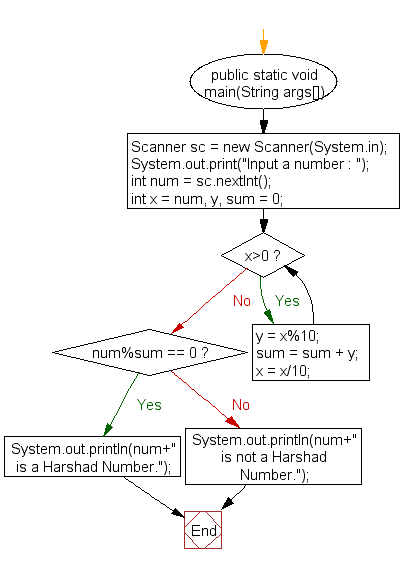Java: Check whether a number is a Harshad Number or not
Check Harshad Number
Write a Java program to check whether a number is a Harshad Number or not.
In recreational mathematics, a harshad number in a given number base, is an integer that is divisible by the sum of its digits when written in that base.
Example: Number 200 is a Harshad Number because the sum of digits 2 and 0 and 0 is 2(2+0+0) and 200 is divisible by 2. Number 171 is a Harshad Number because the sum of digits 1 and 7 and 1 is 9(1+7+1) and 171 is divisible by 9.
Test Data
Input a number : 353
Pictorial Presentation:
Sample Solution:
Java Code:
import java.util.Scanner;
public class Example12 {
public static void main(String args[])
{
Scanner sc = new Scanner(System.in);
System.out.print("Input a number : ");
int num = sc.nextInt();
int x = num, y, sum = 0;
while(x>0)
{
y = x%10;
sum = sum + y;
x = x/10;
}
if(num%sum == 0)
System.out.println(num+" is a Harshad Number.");
else
System.out.println(num+" is not a Harshad Number.");
}
}
Sample Output:
Input a number : 353 353 is not a Harshad Number.
Flowchart:

For more Practice: Solve these Related Problems:
- Write a Java program to compute the sum of digits of a number and check divisibility to determine if it is a Harshad number.
- Write a Java program to generate all Harshad numbers in a given range using iterative search.
- Write a Java program to optimize Harshad number detection by precomputing digit sums for repeated calculations.
- Write a Java program to compare recursive and iterative approaches for checking if numbers are Harshad.
Go to:
PREV : Check Disarium or Unhappy Number.
NEXT : Check Pronic Number.
Java Code Editor:
Contribute your code and comments through Disqus.
What is the difficulty level of this exercise?
Test your Programming skills with w3resource's quiz.
